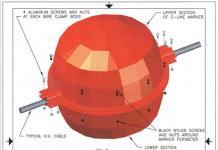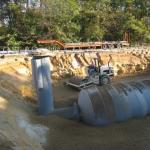Installing rafters, like creating the entire roof, is a very responsible process. Taking into account that the base of the roof can be fixed to the wall using available means for lifting, subsequent work on its creation, which includes the installation of rafters, will be impossible without the installation of scaffolding, which also includes mobile structures. Scaffolding is used to lift materials to the required height; in addition, they can be used as a working platform for people and a place for laying building materials.
Construction of the rafter system.
Preparation of scaffolding and scaffolding
Installing rafters with your own hands may seem very labor-intensive, but if you follow all the tips and do them correctly, the process will be fun. If you are building a house, then you must use at least 3 scaffolds, in any case their number should not be less than 2. For work, it is better to make mobile scaffolding, as they are very convenient. The installation of rafters should begin only after all safety issues have been resolved; in no case should this be neglected, since health is more important than the speed of construction.

Types of rafter systems.
If the house does not have an internal load-bearing wall, that is, there is no additional support, and the construction legs rest only on the outer walls of the house, in this case it is necessary to use hanging rafters.
What are rafters? Translated from Old Russian, this is a structure for supporting a gable roof. And the rafter legs are inclined, with the help of which the roof slope is formed. Rafter legs are usually connected by “headstocks” or “fillies”, which are made vertically. The tie is a horizontal beam, with its help the rafter legs are connected.
Varieties of rafter designs
Roof structures usually contain the following components:

Schemes of layered rafters and their application.
- Rafter legs are used to form a slope.
- To transfer part of the load - columns or internal supports.
- Various inclined elements (struts, braces), which perform the same functions as the racks.
- Elements that fasten rafter legs to each other. Typically, floor beams are used for this.
A triangle is the optimal shape of a roof truss. This design has the greatest rigidity.
Despite the many possible roof shapes, two types of rafters are usually used:
- Layered rafter system;
- Hanging rafters.

Figure 1. Installation of rafters.
The first case is used subject to the presence of internal load-bearing elements in the building structure. In this case, the rafter legs have emphasis not only on the external walls, but also on the internal columns or supports. Racks are used to transfer the load. Figure 1 shows rafter installation diagrams.
The hanging structure has support only on the outer walls, and at the ridge the rafters rest on each other. Hanging rafters are used in the absence of intermediate supports; the span width is less than 12 m. A design feature is a high thrust load; special tie-downs are used to reduce it. The legs of such a rafter system should be strengthened with the help of struts, which will also reduce the pressure on the load-bearing walls.
Walls made of brick or stone require the installation of a Mauerlat. Mauerlat is a wooden beam, which usually has a cross-section of 150x150 mm and is secured with special pins. These studs must be embedded in the wall in advance. A waterproofing layer must be laid under the Mauerlat.
Do-it-yourself installation of hanging rafters on a mauerlat: step-by-step instructions
For work you will need the following tools:

Diagram and installation of hanging rafters.
- axe;
- hammer;
- knife for precise fitting of parts;
- pencil;
- plumb line;
- roulette;
- building level.
To install the rafters, you need to take a beam, the length of which will be 6 m and the cross-section 50x200 mm. It should be noted that if suddenly the cross-section is small, then after some time such a structure may sag. Based on the case described above, the roof slope, namely its angle, should be equal to 33 º. The next step in installing the rafters is that, using scaffolding, you need to lift 2 beams and connect them at the top.

Knots of layered rafters.
- On the rafter legs, you need to “cut the heel” in the following way so that the rafter rests well on the mauerlat.
- You need to do the same with the next rafter. It would be nice if the rafter legs were marked “left” and “right”.
- After completing this work, the rafter legs must be connected.
- After this, at the place where the rafter legs connect, you need to make a “stump” with the correct angle, so that the rafters at the top are not overlapped and then fastened with nails. This method is unreliable, since the rafters rest against each other.
- To perform the “hemp” correctly, you should initially attach one rafter to another, then draw a line for their connection (you can use a pencil for this) and only then saw it off.
- To prepare building material on the ground, you need to measure and make several templates at once.
- Having completed all the operations, we begin installing the rafters first on one pediment, and then on the other. Using nails, we fasten the rafters to the mauerlat.
- The next pairs of rafter legs are prepared using ready-made templates on the ground;
- Then you need to stretch the thread along the ridge between the already completed pairs of rafters and begin installing all the remaining rafters.
- The distance at which the rafters are installed is 70 cm. Of course, in fact it can be within 68-73 cm from each other. This is considered the optimal distance for the roof, since it is reliable, and this distance between the rafters will be convenient later when you stretch the film.
- For these purposes, it is necessary to initially mark the Mauerlat, and then install the rafters along it.
- It is worth noting that the adjustment must always be carried out using a thread that is stretched between the rafters; when necessary, it will be possible to adjust the height of the rafter legs on the spot. In some cases, you need to place small planks under your feet.
- Adjustment in the lower part in width, which is located between the two rafters, is made according to the indicated markings on the Mauerlat. As for the upper part, the adjustment is carried out using a temporary board with the same markings. This means that after each pair of rafters is installed, a board is temporarily nailed to the top of the left and right rafters according to pre-made markings, which correspond to the markings applied to the mauerlat.
- In the described case, the hanging rafters will need to be connected with a horizontal beam, that is, a tie, due to the large distance between the supporting walls. It is worth paying attention to the fact that initially the rafter pairs were connected by a horizontal board in the ridge area, thereby forming a ridge unit.

Installation of a gable roof.
In the case under consideration, due to the large distance between the load-bearing walls, where the width of the house itself is about 11 m, the tie will consist not of one beam, but of several boards interconnected. Such a tightening, made of several boards, will help solve several problems at once:
- The result is a tightening of the required length:
- It is worth noting that the strength and reliability of the tightening made from 3 boards with a total thickness of 60 mm is much higher than if it is one beam 60 mm thick.
Quality roof: summing up
For the required length, 4 and 6 m boards were cut, after which they were fastened with nails, twisted with nuts and studs with rafter legs.
You need to keep the distance between the puffs under constant control. It should be the same as that between the rafter legs.
To do this, you need to use narrow boards, as in the case of adjusting the distance of the rafter pairs at the ridge, which are marked and correspond to the markings on the mauerlat. You must always keep your distance under control!
In addition to all this, the tie and the ridge were connected by another board. Considering the fact that there is no retaining wall, the tie will simply bend, unable to withstand its own weight. To avoid such troubles, the tie together with the ridge of the rafter pair is connected by a “headstock”. All the above actions must be done with each rafter pair.
A gable roof or gable roof is a roof with two slopes, i.e. having 2 inclined surfaces (slopes) of a rectangular shape.
Due to its design features, the frame of a gable roof ideally combines simplicity of design and maintenance with reliability and durability. These and many other parameters make the construction of a gable roof a practical and rational solution for private and commercial housing construction.
In this article, we will look at how to make a rafter system for a gable roof with your own hands. For effective perception of the material, it is presented in the form of step-by-step instructions from A to Z, from selection and calculations, to installation of the Mauerlat and sheathing under the roof. Each stage is accompanied by tables, diagrams, drawings, drawings and photos.
The popularity of the house roof is due to a number of advantages:
- design variability;
- simplicity in calculations;
- naturalness of water flow;
- integrity of the structure reduces the likelihood of leaks;
- efficiency;
- preserving the usable area of the attic or the possibility of arranging an attic;
- high maintainability;
- strength and wear resistance.
Types of gable roof
The installation of a gable roof truss system depends, first of all, on its design.
There are several options for gable roofs (types, types):
The most common roof installation option due to its simplicity and reliability. Thanks to symmetry, a uniform distribution of loads on the load-bearing walls and mauerlat is achieved. The type and thickness of the insulation does not affect the choice of material.
The cross-section of the beam makes it possible to provide a reserve of bearing capacity. There is no possibility of rafters bending. Supports and struts can be placed almost anywhere.
An obvious drawback is the impossibility of arranging a full-fledged attic floor. Due to sharp corners, “dead” zones appear that are unsuitable for use.
 The arrangement of one angle of more than 45° leads to a reduction in the amount of unused area. There is an opportunity to make living rooms under the roof. At the same time, the requirements for calculations increase, because the load on the walls and foundation will be distributed unevenly.
The arrangement of one angle of more than 45° leads to a reduction in the amount of unused area. There is an opportunity to make living rooms under the roof. At the same time, the requirements for calculations increase, because the load on the walls and foundation will be distributed unevenly.
 This roof design allows you to equip a full second floor under the roof.
This roof design allows you to equip a full second floor under the roof.
Naturally, a simple gable rafter roof differs from a broken roof, not only visually. The main difficulty lies in the complexity of the calculations.
Design of a gable roof truss system
Building a roof of any complexity with your own hands requires knowledge of the purpose of the main structural elements.
The locations of the elements are shown in the photo.



- Mauerlat. Designed to distribute the load from the rafter system onto the load-bearing walls of the building. To arrange the Mauerlat, a timber made of durable wood is selected. Preferably larch, pine, oak. The cross-section of the timber depends on its type - solid or glued, as well as on the expected age of the structure. The most popular sizes are 100x100, 150x150 mm.
Advice. For a metal rafter system, the Mauerlat must also be metal. For example, a channel or an I-profile.
- Rafter leg. The main element of the system. To make rafter legs, a strong beam or log is used. The legs connected at the top form a truss.
The silhouette of the roof truss determines the appearance of the structure. Examples of farms in the photo.

The parameters of the rafters are important. They will be discussed below.
- Puff- connects the rafter legs and gives them rigidity.
- Run:
- Ridge run, is mounted at the junction of one rafter to another. In the future, the roof ridge will be installed on it.
- Side purlins, they provide the truss with additional rigidity. Their number and size depend on the load on the system.
- Rafter stand- vertically located beam. It also takes on part of the load from the weight of the roof. In a simple gable roof it is usually located in the center. With a significant span width - in the center and on the sides. In an asymmetrical gable roof, the installation location depends on the length of the rafters. If there is a broken roof and one room is arranged in the attic, the racks are located on the sides, leaving free space for movement. If there are supposed to be two rooms, the racks are located in the center and on the sides.
The location of the rack depending on the length of the roof is shown in the figure.

- Strut. Serves as a support for the stand.
Advice. Installing the brace at an angle of 45° significantly reduces the risk of deformation from wind and snow loads.
In regions with significant wind and snow loads, not only longitudinal struts are installed (located in the same plane as the rafter pair), but also diagonal ones.
- Sill. Its purpose is to serve as a support for the rack and a place for attaching the strut.
- Lathing. Designed for movement during construction work and fixing roofing material. Installed perpendicular to the rafter legs.
Advice. An important purpose of the sheathing is to redistribute the load from the roofing material to the rafter system.
Having a drawing and diagram indicating the location of all the listed structural elements will help in the work.
Advice. Be sure to add information about the passage of the ventilation shaft and chimney to the gable roof rafter system diagram.
The technology of their installation is determined by the type of roof.
Selection of material for rafters
When calculating the material for a gable roof, you need to choose high-quality wood without damage or wormholes. The presence of knots for beams, mauerlat and rafters is not allowed.
For sheathing boards, there should be a minimum of knots, and they should not fall out. The wood must be durable and treated with the necessary preparations that will increase its properties.
Advice. The length of the knot should not exceed 1/3 of the thickness of the timber.
Calculation of the rafter system of a gable roof
Calculating the material parameters is an important step, so we present the calculation algorithm step by step.
 It is important to know: the entire rafter system consists of many triangles, as the most rigid element. In turn, if the slopes have different shapes, i.e. are an irregular rectangle, then you need to divide it into separate components and calculate the load and amount of materials for each. After calculations, summarize the data.
It is important to know: the entire rafter system consists of many triangles, as the most rigid element. In turn, if the slopes have different shapes, i.e. are an irregular rectangle, then you need to divide it into separate components and calculate the load and amount of materials for each. After calculations, summarize the data.
1. Calculation of the load on the rafter system
The load on the rafters can be of three types:
- Constant loads. Their action will always be felt by the rafter system. Such loads include the weight of the roof, sheathing, insulation, films, additional roofing elements, finishing materials for. The weight of the roof is the sum of the weight of all its constituent elements; such a load is easier to take into account. On average, the constant load on the rafters is 40-45 kg/sq.m.
Advice. To make a safety margin for the rafter system, it is better to add 10% to the calculation.
For reference: The weight of some roofing materials per 1 sq.m. presented in the table

Advice. It is desirable that the weight of roofing material per 1 sq.m. roof area did not exceed 50 kg.
- Variable loads. They act at different times and with different strengths. Such loads include: wind load and its strength, snow load, precipitation intensity.
In essence, the roof slope is like a sail and, if you take into account the wind load, the entire roof structure can be destroyed.

The calculation is carried out according to the formula: wind load is equal to the regional indicator multiplied by the correction factor. These indicators are contained in SNiP “Loads and Impacts” and are determined not only by the region, but also by the location of the house. For example, a private house surrounded by multi-story buildings experiences less load. A detached country house or cottage experiences increased wind loads.
2. Calculation of snow load on the roof
The roof calculation for snow load is carried out according to the formula:
The total snow load is equal to the weight of the snow multiplied by the correction factor. The coefficient takes into account wind pressure and aerodynamic influence.
The weight of snow that falls on 1 square meter. roof area (according to SNiP 2.01.07-85) is in the range of 80-320 kg/sq.m.
Coefficients showing the dependence on the slope angle are shown in the photo.

Nuance. When the slope angle is over 60 ° the snow load does not affect the calculation. Because the snow will quickly slide down and will not affect the strength of the beam.
- Special loads. Accounting for such loads is carried out in places with high seismic activity, tornadoes, and storm winds. For our latitudes, it is enough to make a safety margin.
Nuance. The simultaneous action of many factors causes a synergy effect. This is worth considering (see photo).

Assessment of the condition and load-bearing capacity of walls and foundations
It should be borne in mind that the roof has significant weight, which can cause damage to the rest of the building.
Determining the roof configuration:
- simple symmetrical;
- simple asymmetrical;
- broken line
The more complex the shape of the roof, the greater the number of trusses and rafter elements needed to create the necessary safety margin.
The angle of inclination of a gable roof is determined primarily by the roofing material. After all, each of them puts forward their own demands.
- soft roof - 5-20°;
- metal tiles, slate, corrugated sheets, ondulin - 20-45°.
It should be noted that increasing the angle increases the area of space under the roof, but also the amount of material. What affects the total cost of work.

Nuance. The minimum angle of inclination of a gable roof must be at least 5°.
5. Calculation of rafter pitch
The pitch of the gable roof rafters for residential buildings can be from 60 to 100 cm. The choice depends on the roofing material and the weight of the roof structure. Then the number of rafter legs is calculated by dividing the length of the slope by the distance between the rafter pairs plus 1. The resulting number determines the number of legs per slope. For the second, the number must be multiplied by 2.
The length of the rafters for the attic roof is calculated using the Pythagorean theorem.

Parameter "a"(roof height) is set independently. Its value determines the possibility of arranging a living space under the roof, the convenience of being in the attic, and the consumption of material for the construction of the roof.
Parameter "b" equal to half the width of the building.
Parameter "c" represents the hypotenuse of the triangle.
Advice. To the obtained value you need to add 60-70 cm for cutting and moving the rafter leg beyond the wall.
It is worth noting that the maximum length of the timber is 6 m.p. Therefore, if necessary, the timber for the rafters can be spliced (extension, joining, joining).
The method of splicing rafters along the length is shown in the photo.

The width of the roof rafters depends on the distance between opposite load-bearing walls.
7. Calculation of the rafter cross-section
The cross-section of the rafters of a gable roof depends on several factors:
- loads, we have already written about it;
- type of material used. For example, a log can withstand one load, timber - another, laminated timber - a third;
- rafter leg lengths;
- the type of wood used in construction;
- distances between rafters (rafter pitch).
You can determine the cross-section of the beam for the rafters, knowing the distance between the rafters and the length of the rafters using the data below.
Rafter cross-section - table

Advice. The larger the installation pitch of the rafters, the greater the load on one rafter pair. This means that the cross-section of the rafters needs to be increased.
Dimensions of lumber (timbers and boards) for a gable rafter system:
- thickness (section) of the Mauerlat - 10x10 or 15x15 cm;
- the thickness of the rafter leg and tie is 10x15 or 10x20 cm. Sometimes a beam of 5x15 or 5x20 cm is used;
- run and strut - 5x15 or 5x20. Depending on the width of the foot;
- stand - 10x10 or 10x15;
- bench - 5x10 or 5x15 (depending on the width of the rack);
- thickness (section) of the roof sheathing - 2x10, 2.5x15 (depending on the roofing material).
Types of gable roof rafter system
For the roof structure under consideration, there are 2 options: layered and hanging rafters.

Let's consider each type in detail in order to make an informed choice.
Hanging rafters
They are used for roof widths of no more than 6 lm. Installation of hanging rafters is carried out by attaching the legs to the load-bearing wall and the ridge girder. The design of hanging rafters is special in that the rafter legs are under the influence of a bursting force. Hanging rafters with a tie installed between the legs reduce its impact. The tie in the rafter system can be wooden or metal. Often the ties are placed at the bottom, then they play the role of load-bearing beams. It is important to ensure that the tie is securely attached to the rafter leg. Because a bursting force is also transmitted to it.
Advice.
The higher the tightening is located, the greater strength it should have.
If the tightening is not installed, the load-bearing walls may simply “move apart” from the pressure created by the rafter system.
Layered rafters
They are used for arranging roofs of any size. The design of layered rafters provides for the presence of a beam and a stand. The bench lying parallel to the Mauerlat takes on part of the load. Thus, the rafter legs are, as it were, inclined towards each other and supported by a stand. The rafter legs of the layered system work only in bending. And the ease of installation also tips the scales in their favor. The only drawback is the presence of a stand.
Combined
Due to the fact that modern roofs are distinguished by a wide variety of shapes and complexity of configurations, a combined type of rafter system is used.

After choosing the type of rafter system, you can accurately calculate the amount of materials. Write down the calculation results. At the same time, professionals recommend drawing up drawings for each roof element.
Installation of a gable roof rafter system
After the gable roof rafters have been calculated, installation can begin. We will divide the process into stages and give a description of each of them. The result will be a kind of step-by-step instructions containing additional information on each stage.
1. Attaching the Mauerlat to the wall

The beam is installed along the length of the wall on which the rafters will rest.
In log houses, the role of the mauerlat is played by the upper crown. In buildings built from porous material (aerated concrete, foam concrete) or brick, the Mauerlat is installed along the entire length of the load-bearing wall. In other cases, it can be installed between the rafter legs.
Material prepared for the website www.site
 Since the length of the Mauerlat exceeds the standard dimensions of lumber, it has to be spliced.
Since the length of the Mauerlat exceeds the standard dimensions of lumber, it has to be spliced.
The connection of the Mauerlat to each other is done as shown in the figure.
How to connect the Mauerlat?
The beams are cut only at an angle of 90°. Connections are made using bolts. Nails, wire, and wooden dowels are not used.
How to attach the Mauerlat?
The Mauerlat is installed at the top of the wall. The installation technology provides several ways to attach the Mauerlat:
- strictly in the center of the load-bearing wall;
- with a shift to one side.
Advice.
The Mauerlat cannot be placed closer than 5 cm to the outer edge of the wall.
To protect the timber for the Mauerlat from damage, it is laid on a layer of waterproofing material, which most often is ordinary roofing felt.
The reliability of the Mauerlat fastening is an important aspect of construction. This is due to the fact that the roof slope is like a sail. That is, it experiences strong wind load. Therefore, the Mauerlat must be firmly fixed to the wall.
Methods for attaching the Mauerlat to the wall and rafters
 Anchor bolts. Ideal for monolithic structures.
Anchor bolts. Ideal for monolithic structures.
 Wooden dowels. Used for log houses and beams. But, they are always used with additional fasteners.
Wooden dowels. Used for log houses and beams. But, they are always used with additional fasteners.
 Staples.
Staples.
 Stud or fittings. It is used if the cottage is built from porous materials (aerated concrete, foam concrete).
Stud or fittings. It is used if the cottage is built from porous materials (aerated concrete, foam concrete).
 Sliding mount (hinge). Tying in this way allows for the displacement of the rafter legs when the house shrinks.
Sliding mount (hinge). Tying in this way allows for the displacement of the rafter legs when the house shrinks.
 Annealed wire (knitting, steel). Used as an additional mount in most cases.
Annealed wire (knitting, steel). Used as an additional mount in most cases.
2. Manufacturing of trusses or pairs
Installation is carried out in two ways:
- installation of beams directly on the roof. It is not used often, since it is problematic to carry out all the work, measurements, and trimming at height. But it allows you to completely do the installation yourself;
- assembly on the ground. That is, individual elements (triangles or pairs) for the rafter system can be assembled below and then raised to the roof. The advantage of such a system is faster performance of high-altitude work. The disadvantage is that the weight of the assembled truss structure can be significant. To lift it you will need special equipment.
Advice. Before assembling the rafter legs, you need to apply markings. It is very convenient to use templates for these purposes. The rafter pairs assembled according to the template will be absolutely identical. To make a template, you need to take two boards, the length of each of which is equal to the length of one rafter, and connect them together.
3. Installation of rafter legs
The assembled pairs rise to the top and are installed on the Mauerlat. To do this, you need to make a gash at the bottom of the rafter legs.
Advice. Since the slots on the Mauerlat will weaken it, you can only make cuts on the rafter leg. To ensure that the cut is uniform and fits tightly to the base, you need to use a template. It is cut out of plywood.
Methods of fastening the rafter leg are shown in the figure.

You need to start installing rafter pairs from opposite ends of the roof.
Advice. To correctly install the rafter legs, it is better to use temporary struts and spacers.
 A string is stretched between the fixed pairs. It will simplify the installation of subsequent rafter pairs. It will also indicate the level of the ridge.
A string is stretched between the fixed pairs. It will simplify the installation of subsequent rafter pairs. It will also indicate the level of the ridge.
If the rafter system is mounted directly on the roof of the house, then after installing the two outer rafter legs, the ridge support is installed. Next, the halves of the rafter pair are attached to it.
It is worth noting that the opinions of professionals differ on this issue. Some advise using a staggered fastening pattern, which will allow the increasing load to be distributed more evenly on the walls and foundation. This order involves installing one rafter in a checkerboard pattern. After part of the rafter legs is installed, the missing parts of the pair are mounted. Others insist that it is necessary to mount each pair in a sequential manner. Depending on the size of the structure and the configuration of the truss, the rafter legs are reinforced with supports and racks.
 Nuance. Additional structural elements are connected using cutting. It is preferable to fix them with construction staples.
Nuance. Additional structural elements are connected using cutting. It is preferable to fix them with construction staples.
If necessary, you can lengthen the rafter leg.
Methods for splicing rafter legs are shown in the photo.

Advice. The method by which the mauerlat is lengthened (cut at 90°) cannot be used in this case. This will weaken the rafter.

4. Installing the ridge of a gable roof
The roof ridge unit is made by connecting the rafter legs at the top.
Roof ridge structure:
- Method without using a support beam (see figure).

- Method using rafter beams. Timber is needed for large roofs. In the future, it can become a support for the rack.
- Method of laying on timber.

- A more modern version of making a ridge knot can be considered the method shown in the photo.

- Cutting method.

After the rafter system is installed, we perform major fastening of all structural elements.
5. Installation of roof sheathing
The sheathing is installed in any case, and is designed for more convenient movement along the roof during work, as well as for fastening roofing material.
The sheathing pitch depends on the type of roofing material, for example:
- for metal tiles - 350 mm (the distance between the two lower boards of the sheathing should be 300 mm).
- for corrugated sheets and slate - 440 mm.
- We lay a continuous sheathing under the soft roof.
Rafter system of a gable roof with an attic - video:
Conclusion
As you can see, despite its apparent simplicity, the installation of a gable roof rafter system contains many pitfalls. But, based on the recommendations given, you can easily build a reliable structure with your own hands.
21.02.2017 1 CommentThe rafter system of a gable roof is a simple design that can be installed with your own hands even by a novice developer. You just need to make preliminary calculations, familiarize yourself with the details and stages of roof construction, and calculate the materials needed for installation. When making calculations, it should be taken into account that the load-bearing capacity of a gable roof depends on the influence of loads from wind, snow, and the weight of materials on it.
To make the process of building a gable roof rafter system as easy as possible for you, below is detailed step-by-step instructions for installing a rafter system with your own hands.
In contact with
Classmates
Requirements for building materials
 For the installation of a rafter system, the best option would be to use lumber from coniferous wood - pine, spruce or larch, grades I - III.
For the installation of a rafter system, the best option would be to use lumber from coniferous wood - pine, spruce or larch, grades I - III.
The material for the rafters is taken at least grade II, the mauerlat is made from boards or timber of grade II, material of grade II is taken for racks and purlins, the sheathing is made from lumber of grades II-III, it depends on the roof. Crossbars and tie-downs are made of Grade I material. Grade III material can be used on linings and linings.
Note! The lumber must be dry with a moisture content of no more than 20%. Before installation, it should be treated with fire retardants and antiseptics against fungal diseases.
 Lumber should be stored under a canopy, providing protection from the sun and moisture. Level the storage area and cover the lumber with pads for ventilation.
Lumber should be stored under a canopy, providing protection from the sun and moisture. Level the storage area and cover the lumber with pads for ventilation.
For installation you will need fastening elements: ties, plates, studs, bolts with washers and nuts, self-tapping screws with EPDM gaskets, 2.8 mm thick, mounting tape, galvanized brackets.
Brackets are used when attaching the Mauerlat; they are secured with nails or self-tapping screws.
KR corners serve to attach the rafters to the mauerlat and prevent the rafters from moving.
All fastening material must be made of high quality material and be protected against corrosion.
Tools for constructing a rafter system
 To install a gable roof rafter system, you will need the following set of tools:
To install a gable roof rafter system, you will need the following set of tools:
- tape measures of different lengths 5, 10, 20 meters;
- markers, pencils;
- cord for tensioning;
- hammers, for various purposes, nail puller;
- scissors, for cutting;
- roofing knife;
- putty knife;
- scotch;
- hacksaws, electric saw, electric drill with various drills and attachments;
- screwdriver with attachments;
- markings, horizontal and vertical levels;
- slats, rulers;
- polyurethane foam;
- safety belt and rope - for safe work.
Keep all tools on the roof in a tool bag for safety reasons.
Types of rafter systems for a gable roof
Sent rafters
They rest on the mauerlat and racks installed on the internal wall, with a pitch equal to the rafters. To provide rigidity for spans of 6 m, additional struts are installed.

Scheme of layered rafters of a gable roof
Hanging rafters
If the building is small in width, you can arrange a rafter system where the rafters rest on the mauerlat or walls, without intermediate supports. The maximum span is 9 meters. Such roofs can sometimes be installed without a Mauerlat. The rafters are installed on the wall using spacers; in this embodiment, a bending moment acts on the rafters.
To unload, wooden or metal plates are installed. They securely strengthen the corner. For hanging rafters of a larger span, a headstock and struts are installed. For hanging systems, the rafters are made with a larger cross-section, and lumber is chosen at least grade I II.

Scheme of hanging rafters of a gable roof
Calculation of the rafter system
 You can determine the cross-section of a gable roof beam required in a rafter system by collecting all the loads acting on it: the weight of the covering, sheathing, snow, wind pressure, precipitation.
You can determine the cross-section of a gable roof beam required in a rafter system by collecting all the loads acting on it: the weight of the covering, sheathing, snow, wind pressure, precipitation.
Constant loads can be determined by the weight of 1 m 2 of roofing and sheathing. It is important that the weight per 1 m 2 of roofing be in the range of 40-45 kg.
Variable loads from snow and wind are calculated using tabular values of SNiP normative documents, depending on the height of the building and temperature zone. The load from snow is equal to its weight multiplied by a coefficient depending on the slope of the slope. All these calculations are performed during the project.
What if there is no project and the roof is being erected on a small building? You need to look at the construction of a house in the neighborhood, which is being carried out according to a design whose roof area is the same as your building. The gable roof rafter system will serve as a model.
Dimensions of timber for rafters
At the top point a ridge is laid that connects the rafters. The height of the ridge depends on the slope of the roof. The slope is affected by the choice of coating material. The minimum sizes are:
- for tiled roofs, slate 22 gr.;
- for metal tiles - 14 g;
- ondulin - 6 g;
- corrugated sheeting - 12 gr.
The optimal angle is 35-45 degrees. tilt, ensures rapid discharge of water and snow. In regions with strong winds, the roofs are made flat and then the angle of inclination is within 20-45 degrees.
The height can be determined using the formula: H=1/2Lpr*tgA. Where A is the angle of inclination, L is the width of the building.
The task is simplified when using a ready-made table. The coefficient depends on the width of the building and the angle of inclination. Multiply the coefficient by 1⁄2 the width of the building.
The rafters are made from pine or spruce bars, with a section of 50x100 mm, 50x150 mm.
The size of the rafters depends on the pitch. The pitch of the rafters is smaller, a larger number is installed, and the cross-section will decrease. The distance between the rafters on a gable roof ranges from 600 mm to 1800 mm, it all depends on the design of the roof and the materials used for its construction.
|
Length rafters, mm |
Distance between rafters, mm | Rafter beam cross-section size, mm |
| up to 3000 | 1200 | 80×100 |
| up to 3000 | 1800 | 90×100 |
| up to 4000 | 1000 | 80×160 |
| up to 4000 | 1400 | 80×180 |
| up to 4000 | 1800 | 90×180 |
| up to 6000 | 1000 | 80×200 |
| up to 6000 | 1400 | 100×200 |
The roof does not end at the level of the walls; it is extended outward by 500 mm. The rafter leg can protrude, or a board or block can be built up. In this case, moisture does not get on the wall and the foundation is not poured.
Step-by-step installation of a gable roof truss system
The rafter system of a gable roof consists of the following elements:
- Mauerlat.
- Lay down.
- Racks.
- Rafters.
- Struts.
- Puffs.
- Lathing.

Mauerlat installation

Fastening the Mauerlat to a monolithic reinforced concrete belt
Mauerlat evenly distributes the load on the walls of the building; its installation can be done in several ways:
- attached to the wall through a reinforced concrete belt with studs;
- studs are inserted into the masonry;
- a simple and common method for simple roofs, fastening with wire rod.
For it, take timber with a cross section of 100×100 mm, 150×150 mm or 200×200 mm. Which section to choose depends on the size of the roof and its covering. The Mauerlat is joined along its length; to do this, make 100 mm cuts, 500 mm long, fold the bars and fasten them with pins.
In the corners, the mauerlat is tied with notches into the floor of the timber, fastened with staples or bolts. For wooden buildings, the Mauerlat is the last crown. On brick walls, make a monolithic reinforced concrete belt with a cross-section of 400×300 mm. Along the belt, place threaded pins 12 mm in diameter, every 120 mm, for fastening.
Drill holes with a diameter of 12 mm in the Mauerlat, lay them so that the pins go into the holes. Tighten the top with nuts. First, we lay two layers of roofing felt or roofing felt under the block. On the outside of the wall, lay the mauerlat with bricks. Lay the Mauerlat on a horizontally and vertically level base. You need to check with a level that the surface is horizontal. Check diagonals. If necessary, level with pads.
Installation instructions for beds, racks, rafters, struts and tie rods
The installation of a gable roof rafter system with your own hands is carried out in the following order:
- Install the beam with the rafters in place.
- Mark the installation step of the rafter legs.
- Prepare according to the size of the rack.
- Install them if there is a need to secure them with spacers.
- Lay the purlin. Check geometry. Install fasteners.
- Try on the first rafter leg and mark the cutting areas.
- Mark the points and install the rafters at the beginning and end of the roof, stretch the cord between them in order to align the remaining elements along it.
- Having installed the rafter leg, we first attach it to the mauerlat, then to the ridge purlin, to each other.
- Screw each second leg to the mauerlat with wire.
The rafters are fastened to the mauerlat using notches, stop corners and a hemmed support bar. Secure with nails or staples.

Methods for attaching rafters to the Mauerlat
Install the support posts on the beds or pads and overlays. A log is a beam 50×100 mm or 50×150 mm, laid on the middle wall along a layer of roofing felt. Place brick pillars under the linings, 2 bricks high.
The rafter legs are connected to each other at the ridge. Let's consider the common connection nodes of the rafter system:
- They make cuts at one leg and cut down at the other. Insert one leg into the cut of the other and fasten with a bolt.
- Install overlays, wooden or metal.
- Using notches in the purlin, they are secured with nails or bolts.

Methods for connecting rafters on a ridge
To ensure the roof's resistance to wind loads, tie-rods, struts and purlins are installed. The tightening is a 100×150 mm block, purlins and struts are made from a 50×150 mm or 100×150 mm block.
With the installation of contractions, the reliability of the rafter structure increases. The sections of the timber are the same as the rafters. They are attached to the legs with bolts or nails. The device of struts adds rigidity to the structure. They are installed tightly to the surface of the rafters
The lumber has a standard length of 6 m. The rafters can be longer. Then you need to dock them. There are several connection methods:
- Fasten by placing bars on both sides at the junction, connecting them with nails in a checkerboard pattern.
- Connect with an overlap, one part of the rafters to another, at a distance of 1 meter, fasten with nails in an alternating order.
- Make a cut obliquely, cut out part of the rafter legs, connect them, strengthening them with bolts.
Sheathing device
 Lathing is installed along the roof rafters. It serves to distribute the load from roofing material and snow onto the rafters. Plays the role of an air gap between the roof and the rafter system.
Lathing is installed along the roof rafters. It serves to distribute the load from roofing material and snow onto the rafters. Plays the role of an air gap between the roof and the rafter system.
The design of the sheathing depends on the roofing material used:
- under the soft tiles, make the sheathing continuous, lay an anti-condensation film on the rafters, press it on top with a counter batten, nail the sheathing onto it, then OSB boards and underlayment carpet, lay the tiles on top.
- Under the roof made of corrugated sheets, the sheathing should be sparse. The pitch of the sheathing depends on the brand of corrugated sheeting, its thickness and the angle of inclination of the roof.
- The lathing for standard slate should be made in increments of 500 mm from a bar of 75×75 mm or 50×50, as well as boards from 30×100 mm. The design features of the roof should be taken into account when making the final choice of the appropriate option.
The lumber from which the sheathing is made is first or second grade pine. It is advisable to take the width no more than 14 cm. With a wider width, the boards may warp and damage the roofing. The length of the nails should be three times the thickness of the sheathing. Lay the boards along the ridge. Install the first board of greater thickness to the height of the roofing.
Install continuous sheathing along the roof slope.
The first layer is to place a board along the ridge from it at a distance of 500-1000 mm to the next one and so on. Lay the second layer of sheathing along the rafters. Place the joint between the boards only on the rafters at intervals. Sink the nail, head and all, into the flesh of the wood.
Cornice overhangs
They are installed to protect against precipitation and play an aesthetic role. Eaves overhangs are arranged tightly without gaps. The final stage of installing the roof.

Diagram of the eaves overhang of a gable roof
Gable
The gable roof has two gables. They have the shape of a triangle, with the apex at the ridge and the sides coincide with the slopes of the roof. The gables support the rafters and enclose the attic space. They protect from wind and precipitation and provide stability to the roof.
In wooden buildings, the pediment is framed. In brick buildings, frame or brick. Gables made of brick or gas block are erected before the roofing is installed. They require very precise execution.
Frame pediments fit into the finished opening when the rafter system is already assembled.
The frame is made of bars or boards. The frame elements are connected on tenons or in the wood floor, all fastened with nails. They are sheathed by nailing boards, lining or siding, maintaining the color scheme in the decoration of the building facade. To construct a window opening, an additional frame is made under it according to the size of the window. If the attic is insulated, then the gable also needs to be insulated. The insulation is placed in the middle of the frame. Mineral wool insulation with reduced flammability is used. On the outside, the frame is covered with a hydro-windproof film or windproof membrane; on the inside, a vapor-proof film or a vapor-proof membrane is nailed under the finishing material.
In contact with
Erection of the roof is one of the most critical stages of construction. The durability of the building itself and the level of comfort of living in it directly depend on the reliability of the “umbrella” on top, on its resistance to precipitation and any external influences.
Of all the variety of roof designs, the gable roof can be considered one of the most popular, simply due to the relative ease of its construction. However, even behind this “simplicity” lies a lot of different nuances, the need to carry out certain calculations and follow technological rules. However, this publication has the main task: to show that installing gable roof rafters with your own hands is a completely doable task, even for a novice builder.
Let's go through all the stages of the process of installing rafters for such a roof, from the basics of preliminary design to an example of practical implementation.
General structure of a gable roof
Basic Concepts
Structural elements of a gable roof truss system

Let us immediately make a reservation that this diagram, of course, cannot reflect the entire possible variety of designs, but the main parts and assemblies are shown quite clearly on it.
1 - Mauerlat. This is a board or beam that is rigidly attached to the upper end of the external load-bearing walls of the building. Its purpose is to uniformly distribute the load from the entire roof system onto the walls of the house, creating conditions for reliable fastening of the rafter legs at their lower support point.
2 – rafter legs installed in pairs. They become the main load-bearing parts of the entire roof system - it is the rafters that determine the steepness of the slopes, will be the basis for attaching the sheathing, roofing, and if the roof is planned to be insulated, then also the entire thermal insulation “pie”.
To make rafter legs, high-quality boards or timber are used; round timber can also be used. The cross-section of lumber, which will be sufficient to guarantee withstand all possible loads, will be discussed below.
The rafters can end at the mauerlat, but more often they extend beyond the perimeter of the walls of the house, forming a cornice overhang. However, lighter parts can also be used for this - the so-called “fillies”, which are used to extend the rafter legs to the required overhang width.
 To form the eaves overhang, the rafters are extended with “fillies”
To form the eaves overhang, the rafters are extended with “fillies” 3 - ridge run. It could be a beam, a board, or even a composite structure. The purlin runs along the entire line of the ridge and serves to reliably connect the upper points of paired rafter legs, connecting all rafter pairs in order to impart overall rigidity to the entire roof structure. In various roof options, this purlin can be rigidly supported by racks, or linked only to the connection node of the rafter legs.
4 – tightening (contracts, crossbars). Horizontal reinforcement parts of the system, additionally connecting paired rafter legs to each other. Several puffs located at different heights can be used.
5 – floor beams, which will serve as the basis for installing the floor in the attic and the ceiling on the side of the room.
6 - and this beam simultaneously serves as a bench. This is a beam that runs along the entire length of the roof, which serves as a support for installing additional reinforcement parts for the rafter system. The beam can be installed as shown in the figure (like a floor beam), or it can be rigidly laid on a permanent partition inside the building.
7 – racks (headstocks) – additional vertical supports of the rafter legs, preventing them from bending under the influence of external loads. The racks at the top can rest against the rafters themselves, or into an additional purlin that longitudinally connects the rafter legs at a certain height.

8 – struts. Often, when the rafter legs are long, their load-bearing capacity is not enough, and reinforcement with racks alone does not provide the necessary strength. In these cases, diagonal reinforcing elements are used, resting on the bottom of the beam, creating an additional support point for the rafters. The number of struts and their installation location may vary in roofs of varying degrees of complexity.
Some differences between the hanging and layered gable roof systems
Gable roofs can be divided into two types of structures - with layered and hanging rafters. In addition, combined systems are widely used, in which both construction principles are combined. What is the fundamental difference?
Layered rafter system
This rafter system design is characterized by the presence of support on the internal main partition in the building. At the upper end of this partition, a bench is mounted on which the drains supporting the ridge girder rest. Thus, the rafter legs are “leaned” onto a vertical support, which makes the entire system as strong as possible.

This type of scheme is the most popular because of its reliability and relative ease of implementation. If it is possible to create an additional point of support in the center, then why not take advantage of it? True, if you plan to place living space in the attic, then vertical racks can sometimes become a hindrance. However, their presence is also sometimes “played up”, using, for example, to install an internal light partition.
Depending on the number and placement of internal partitions, the design of the layered rafter system may vary. Some examples are shown in the illustration below:

Fragment “a” shows the simplest option, which, by the way, on short rafter lengths (up to 5 meters) may not even have the shown struts - a row of central posts under the ridge girder is enough
As the width of the building increases, the system naturally becomes more complex, and additional reinforcing elements appear - tie rods and struts (fragment “b”).
Fragment “c” clearly demonstrates that the internal main wall does not have to be located exactly in the center, under the ridge. An option as shown in the illustration is also quite possible, but with the condition that the displacement of the bed relative to the ridge does not exceed one meter.
Finally, fragment “d” shows how a rafter system can be supported in a large building, but with two main partitions inside. The distance between such parallel beams can reach up to a third of the width of the building.
Hanging rafter system
Graphically, this roof diagram can be depicted something like this:

It is immediately noticeable that the rafters rest only on the lower part, and then are connected to each other at the ridge. There is no additional support in the center, that is, the rafter legs seem to “hang”, which determines the name of such a system. This feature imposes certain restrictions on the use of hanging rafters - usually this scheme is practiced when the distance between the load-bearing walls to which the Mauerlat is attached is no more than 7 meters. The installed puffs only partially relieve the load from the external walls.
The illustration below shows several options for a hanging system. However, some of them can rather be classified as combined.

Fragment “d” - hanging rafters are connected to each other by a tie at the level of the mauerlat or fixed to a powerful floor beam, forming a triangle with it. There are no other reinforcing parts. A similar scheme is acceptable with a distance between walls of up to 6 meters.
Option “w” is for a house of the same size (up to 6 meters). The tie (bolt) in this case is shifted upward, and is often used for lining the attic ceiling.
Options “e” and “z” are designed for a span between walls of up to 9 meters. Multiple tie-downs may be used (or a top tie-down in combination with a bottom joist). Another approach is to install racks under the ridge girder, similar to the layered system. Only, as the lower point of support, it is not the support on the main partition that is used, but the racks are supported by a tie or a floor beam. It is already difficult to call this option purely “hanging”, since here it is clearly a combination of parts from both designs.
To an even greater extent, this combination of two schemes is expressed in the “and” option, which is designed for large spans, from 9 to 14 meters. Here, in addition to the headstock, diagonal struts are also used. Often such trusses are assembled on the ground, and only then they are lifted and installed in place, connected to each other, thereby forming the entire roof frame.
So, when preparing for the construction of a gable roof, it is necessary to study the principles of the design of a particular system, evaluate their advantages and disadvantages, choose the optimal one for your conditions and draw up a graphical working diagram. It will be needed both when purchasing the necessary material and for carrying out the installation work itself. However, drawing up a drawing must still be preceded by some calculations.
Calculation of the basic parameters of a gable roof rafter system
Let's take another look at the schematic diagram of a gable roof to highlight the parameters that will need to be calculated.

So, in the calculation process we will need to decide on the following values.
The initial data is the length of the side of the house along the gable part (highlighted in blue - F), and the length of the house along the ridge (purple - D). It is assumed that the owners have already decided in advance on the type of roofing - since there will be certain restrictions on the steepness of the roof slopes. (angle a).
- The height of the ridge above the plane of the Mauerlat (H - green), or, conversely, determine the angle of the slope, starting from the planned height of the ridge.
- The length of the rafter leg (blue color - L), and, if necessary, lengthening the rafters to form a cornice overhang of the required width (l).
- Calculate the total loads falling on the rafter system in order to determine the optimal cross-section of lumber for the manufacture of rafters, the pitch of their installation (red color - S) and the permissible length of spans between support points. All these parameters are closely interconnected.
- Once you have these calculated values in hand, it is no longer difficult to draw up a graphical diagram, determine the need and optimal location of reinforcement elements, and calculate the amount of material for their manufacture.
Chainsaw prices
chainsaw
We calculate the steepness of the slope and the height of the ridge
The steepness of the slopes can be determined by the owners according to various evaluation criteria:
- For purely aesthetic reasons - when the appearance of the building becomes “of paramount importance”. Many people like roofs with a high ridge, but we must not forget that the wind load on such a roof increases sharply. And there will be immeasurably more materials needed to make a high roof. At the same time, on steep slopes the snow load is reduced to almost zero - it is possible that for “snowy” regions this assessment parameter may become decisive.
- For reasons of beneficial use of the attic space. With a gable roof scheme, in order to achieve the maximum area of the attic, it is necessary to build slopes with a very large steepness, that is, with the same consequences as mentioned above.

- Finally, there may be a completely opposite approach - for reasons of economy, make a roof structure with a minimum height at the ridge. But in this case, you will have to focus on the minimum permissible slope angles for a specific type of roofing. Reducing the slope below the values recommended by the manufacturer means “planting a bomb” in your roof, both for reasons of its strength and durability, and from the standpoint of the waterproofing qualities of the coating.
Calculating the height of the ridge above the plane of the ceiling (mauerlat) is not difficult. The vast majority of components of any roofing system are based on a triangle, which, in turn, obeys strict geometric (more precisely, trigonometric) laws.
So, in our case, the width of the roof along the gable line is known. If the roof is symmetrical, then the ridge will be placed exactly in the middle, and for calculations you can simply divide the width F by two (the base of the triangle f =F/2). For asymmetrical slopes, you will have to project the top of the ridge onto line F, and measure the distances f1 and f2 from it to the edge of the triangle (to the Mauerlat) on each side. Naturally, in this case the slope of the slopes will be different.
N =f×tga
In order not to force the reader to look for tangent values and carry out calculations manually, below is a calculator in which the necessary tabular values have already been entered.
The rafter system is the roof frame, which is the basis for laying roofing coverings.
The rafter system is designed to withstand the load of the roof, taking into account natural loads: winds, snow, rain.
The roof option is approved at the design stage.
The purpose of the roof includes several functions: warmth in the house, protection of the premises from natural phenomena, therefore The rafter system needs to be given special attention.
You can read how to calculate the rafter system.
It is customary to classify rafter systems so that the task of choosing a future roofing option is solved easier:
- Single-pitch. The simplest ones. More suitable for utility rooms, bathhouses, small private houses, gazebos. Provides for an inclined position of the structure at a slight angle (no more than 25°);
- Gable. Used for small houses and country houses. They have the form of a triangle, in which the rafter boards are connected by a beam and are at a certain angle;
- Gable broken lines. They have two slopes with a fracture, thanks to which there is an opportunity to increase the attic area;
- Three-slope (half-hip). They have two trapezoid-shaped slopes, which are connected by one end triangular slope (hip);
- Four-slope (hip). Used for residential buildings, require significant labor costs. They have two end triangular slopes and two trapezoidal ones;
- Tent. Used for square-shaped buildings. They consist of four triangular slopes, the upper corner of which is connected in the center of the roof;
- Multi-pincer. Consist of trapezoidal or other slopes of various shapes, connected to each other.
The most suitable designs for - and broken gable. There are others, but they are less common and not as practical as the above.
Rafter structures are also classified into:
- Hanging. With this type of roof frame due to the lack of load-bearing walls in the room;
- Layered. Rafter installation option, providing support on a load-bearing internal wall or support in a building.
When designing a building, the material for the roof frame is calculated based on the intended configuration and load. It’s not difficult to make rafters for yourself, it’s important to approach the matter wisely.

Rafter systems of layered and hanging type
Calculation of the load on the rafters
To correctly calculate the load on the rafters, it is necessary to take into account many factors that can affect the weight of the structure.
Important indicators to consider:
- Constant load: includes the mass of the roofing pie and covering material;
- The load is temporary: constant and maximum amount of snow, rain, intensity of wind gusts, and in areas with high seismic activity - the effect of storm winds, tornadoes, hurricanes.
In addition, you should keep in mind the weight and strength of the rafter legs, and also pay attention to the fastening of the gable roof rafters and the installation option.

Scheme of rafter systems
The distance between the rafters of a gable roof and the thickness of the rafters
 The rafter pitch of a gable roof is the empty space between the rafters. The functionality of the roof depends on the correct calculation of the pitch. As a rule, the step is about a meter.
The rafter pitch of a gable roof is the empty space between the rafters. The functionality of the roof depends on the correct calculation of the pitch. As a rule, the step is about a meter.
To more accurately calculate the distance between rafter boards, there is a specific calculation scheme:
- Determine the length of the slope.
- The length of the slope is divided by the distance between the rafters.
- To determine the number of rafters, one is added to the resulting value and rounded up. This is how they determine how many boards are needed for the slope.
- The length of the slope is divided by the number of boards to obtain the distance between the rafters.
This calculation is not always final.
Additionally, you should take into account the load of the roofing (its weight), the thickness of the rafters, as well as the dimensions of the rafters for a gable roof.
The thickness of the rafter board largely depends on the covering material:
- . Boards are used with a cross-section of 5x20 cm at a pitch of 60 to 90 cm with a sheathing section of 4x5 cm;
- . Rafter boards - 5x15 cm, pitch - from 60 cm to 95 cm;
- . The section of the board is 6x18 cm or 5x15 cm, the distance between the bars is from 80 cm to 130 cm;
- . Rafter cross-section - 5x15 cm, 5x10 cm with pitches from 60 cm to 90 cm;
- . The cross-section of the beam is the same as for corrugated sheeting at a pitch of 60-80 cm.
All indicators should be taken into account and the thickness of the rafters should be accurately calculated so that there is no excessive load on the foundation.
Incorrect calculation of the length of the gable roof rafters, as well as incorrect calculation of the pitch indicators, can lead to sagging of the roof.
Installing the rafters of a gable roof with your own hands requires taking into account the weight of the rafter board and all additional fastenings of the structure.

What does the rafter system consist of?
Rafter structure is a complex system and installing a gable roof rafter system is not an easy task. Rafter system consists not only of rafter boards, but also of other additional elements:
- Mauerlat. An element that distributes the entire load evenly across the supports;
- Run. Boards holding the legs of the rafters together: at the top - a ridge, at the side - a side girder;
- Puffs. A connecting beam that prevents the rafter legs from diverging;
- Struts, racks. The bars, which fix the stability of the rafters, resting on the bed;
- . A lattice made of bars, which is applied perpendicular to the rafters. Transfers the load of the covering material to the rafter frame;
- . A connecting beam that serves as a connection between the roof slopes;
- Fillies. If the length of the rafter legs is insufficient, they are mounted to form an overhang;
- Roof overhang. Extends beyond the bottom line of the slope to prevent precipitation from entering the walls.
The rafter system involves rafters, braces, braces and racks located in the same plane. They are located in such a way that the main load of the roof structure falls vertically on the external load-bearing walls. Therefore, the manufacture of gable roof rafters is a very important process.

What does a gable roof truss system consist of?
Installation of a rafter system with layered rafters
A layered rafter system is used when the span length does not exceed 6.5 meters.
If there are load-bearing structures inside the building, it is possible to install additional racks.
The main support of the rafter legs is the mauerlat.
Mauerlat installation
Before installing the Mauerlat, it is necessary to install an armored belt. It consists of formwork, into which reinforcement is laid and filled with concrete. At the base, when the concrete has not yet hardened, studs are installed, to which the Mauerlat is then attached.
Mauerlat is a beam that is laid on a support (load-bearing wall) and is the base of the rafter frame. A layer of waterproofing material is pre-laid. If the length of the beam is not enough to cover the length of the wall, then it is increased.
- Check the equality of the diagonals. A discrepancy of a few centimeters can lead to refurbishment of the frame;
- Secure the corners of the Mauerlat;
- Attach the Mauerlat using pins or wire. The studs are tightened in two steps, having previously drilled holes for them.
The stability of the roof structure depends on how firmly the Mauerlat is installed.
Therefore, it is necessary to take seriously the attachment of the Mauerlat to the supporting support.

Mauerlat installation
Sill
After the Mauerlat has dried (after 5 days), mark the installation of the plank on the Mauerlat timber: its axis should be equally spaced on each side of the mauerlat beam. The bed is attached to a two-layer waterproofing layer with anchor bolts. The bench should be secured to the wall from the inside with twisted wire or staples. Next, markings are made for installing the rafters.

Installation of a gable roof rafter system
The supporting points of layered rafters are the walls and racks inside the frame. The rafters are mounted with hinged fastening units. When using sliders for fastening, a slight lowering of the roof frame is ensured in the first years of the roof's service.
This installation method is necessary to prevent distortions, since in the first years the building settles a little.
The rafter beams should be secured either by installing them in prepared grooves and strengthening them with fasteners, or by attaching board overlays.

Installation of rafters
Ridge knot
The rafters are connected end-to-end by cutting the edge of the beam so that the angle when connecting the opposite beams corresponds to the angle of the slope. They hammer the rafters under the ridge with nails. An option is possible in which the beams are connected with bolts, nails or pins, that is, with an overlap.
If necessary (if provided for by the project), a cut is made in the rafter beams to attach the ridge beam (purlin).

Ridge knot
Racks
The racks are attached with a short span - in the center, on the sides and in the center - with a wider roof base. The fastening is carried out vertically from the ridge to the inner wall.

Run
Purlin - a connecting beam for securing rafter legs. Attaches with bolts or brackets to the rack.

Filly installation
The final stage of installation of the layered system is the installation of fillets with a short length of rafter legs for the overhang. To install the canopy, it is necessary to install additional small rafter boards.


Installation of a rafter system with layered rafters
DIY gable roof rafter system: installation with hanging rafters
Rafter system, equipped with hanging rafters, is a triangular structure, where the sides are rafters, and the base is a tie connected to the lower heels of the rafters.
Installation of a hanging type rafter frame can be done without installing a Mauerlat: a board that is fixed to a two-layer waterproofing can replace it.
If the structure has a large span, then struts, headstocks, and crossbars are attached to it.
There are no racks in the hanging system.
Puffs
The tie is the longest beam of the roof frame. To prevent it from sagging, it is necessary to attach headstocks - boards that are attached to the top of the structure on one side, and to the tie on the other. Fastened with bolts or wooden plates. Using threaded clamps, you can adjust the sagging tightening.

Construction of the rafter system
Installation of strut beams
The headstock can be complemented by strutted beams, forming a rhombus, where two struts are the lower sides, and the rafters are the upper ones, the upper corner is the ridge. Thus, the struts rest against the headstock, distributing the load.

Strut beams
Rafters
The rafters of a hanging structure are mounted similarly to a layered structure. When installing attics, the tie is installed closer to the ridge, providing more space under the ceiling. In this case, the tightening is secured by cutting and bolting.
ATTENTION!
When installing a hanging system, a prerequisite for installation is the accuracy of calculations and the strength of the rafters and tightening.
The presence of errors leads to displacement of the axes of system elements, which ensures distortion of the structure.
This photo will tell you how to install rafters for a gable roof:

Installation of rafters

Hanging rafters
How to strengthen the rafters of a gable roof
 It is necessary to strengthen the rafters of a gable roof when the load calculation is incorrect or frame defects are detected.
It is necessary to strengthen the rafters of a gable roof when the load calculation is incorrect or frame defects are detected.
Strengthening can be done using:
- Beams, which are installed to transfer the load to them;
- Installation of struts with an inclined mount with an emphasis on the bed;
- Application of double-sided slats;
- Increasing the cross-section of rafter beams in the place of supports on the strut by applying sheathing from boards with nails or bolts;
- Wall made of boards, which are attached to the rafters in places where snow accumulation is expected to increase the load-bearing capacity of the rafters.
You can resort to strengthening the mauerlat beam and the base of the rafter beam. Due to increased humidity and reduced ventilation, these parts of the frame are more susceptible to rotting, so when arranging the roof special attention needs to be paid




















